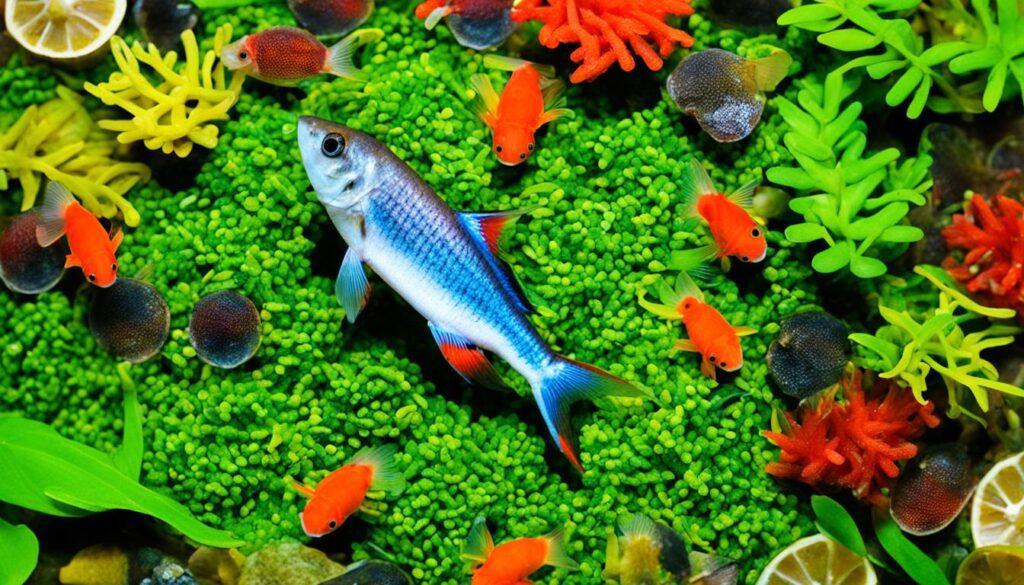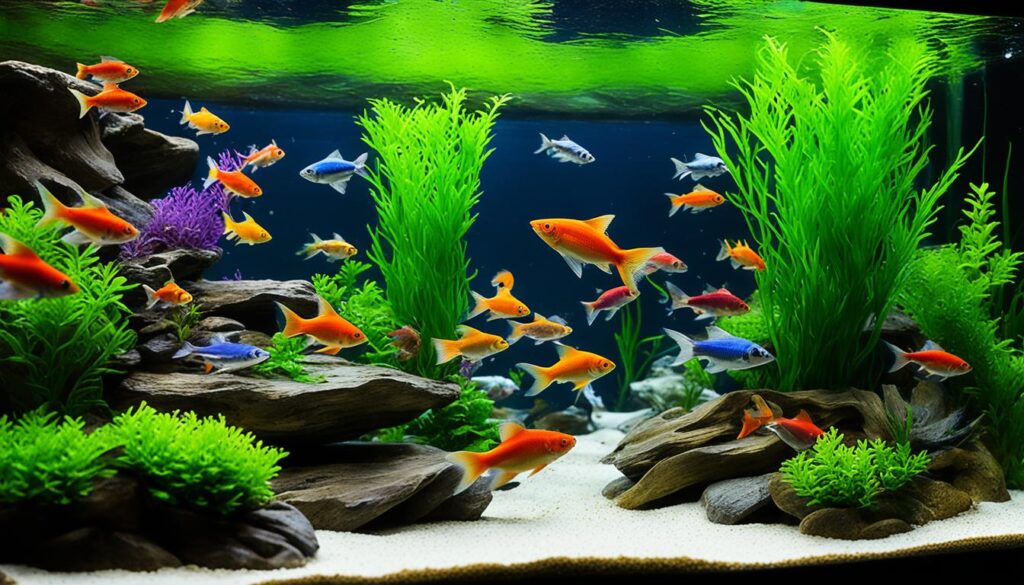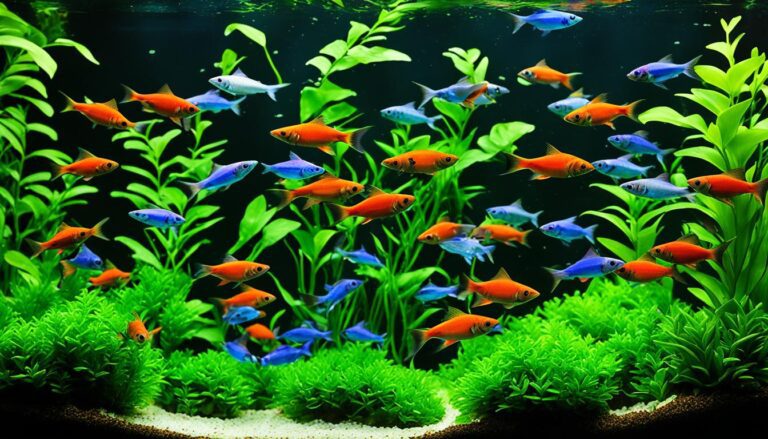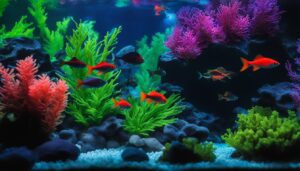I’ve always been drawn to the vibrant colors and shimmering scales of the Congo Tetras. These fish, from the Congo River Basin in Africa, are popular for their beauty and easy care.
Congo tetras shine with iridescent colors, changing from blue and green to purple and red in different lights. Their slender bodies and long fins make them look elegant. In groups, they create a beautiful display that makes any aquarium stand out.
This guide will cover everything about Congo tetras. I’ll share my knowledge on their size, lifespan, breeding, tank setup, water needs, and tank mates. It’s great for both beginners and experienced aquarists looking to create the perfect home for these fish.
Overview of the Congo Tetra

Congo Tetras are a stunning type of freshwater fish loved by aquarium fans all over the world. They stand out with their bright colors and lively nature. This makes them a favorite for community tanks. Let’s explore where they come from, their natural home, and what they look like.
Origins and Natural Habitat
Congo Tetras come from the Congo River Basin in Africa, in the Democratic Republic of the Congo (formerly Zaire). They live in murky, slightly acidic waters. They like places with low light and have sand, silt, and mud on the bottom, just like their home.
In the wild, they swim together in big groups for safety and to find food. They live near tall plants, which helps them hide from predators. The water is soft and acidic, with a pH of about 6.0 to 7.5.
Physical Characteristics and Appearance
Congo Tetras are known for their shimmering colors. They have flat bodies covered in large scales that reflect light, showing off blue, gold, red, and violet colors. Males are bigger and more colorful than females.
Characteristic |
Male Congo Tetra |
Female Congo Tetra |
|---|---|---|
Size |
Up to 3.0 inches (8.5 cm) |
Up to 2.75 inches (6 cm) |
Coloration |
Vibrant iridescent colors, violet fins with white edging |
Mostly golden with shades of silver and green |
Fin Shape |
Longer, flowing fins with an elongated middle section in the tail fin |
Shorter, less elaborate fins |
Sexual dimorphism is clear in Congo Tetras, with males showing off more color and longer fins. The male’s tail fin is longer and more flowing, adding to their beauty. Females are mostly golden with silver and green touches.
Congo Tetras are known for being peaceful and active. They love to be in groups, making any aquarium more lively. Their beauty and lively nature make them a favorite among fish keepers.
Congo Tetra Size and Lifespan
Congo tetras grow to impressive lengths in the wild, up to 3.5 inches. But in tanks, they usually reach 2.5 to 3 inches. Their size can change based on diet, water quality, and living conditions.
These fish can live for 3 to 5 years with proper care. Their lifespan depends on genetics, diet, water quality, and stress levels in the tank.
Keeping Congo tetras healthy means feeding them well and maintaining good water conditions. A balanced diet of flakes, pellets, and live or frozen foods helps them grow and live longer.
Congo Tetra Size and Lifespan |
Details |
|---|---|
Adult Size (Captivity) |
2.5 to 3 inches |
Adult Size (Natural Habitat) |
Up to 3.5 inches |
Life Expectancy |
3 to 5 years |
Many factors can affect how long Congo tetras live. I once saw a male Congo tetra die from popeye and fin damage. This shows that even with good care, these fish can face health issues that shorten their lives.
Knowing about Congo tetras’ growth, size, and lifespan helps aquarists care for them better. This way, we can enjoy these beautiful fish for many years.
Setting Up the Ideal Congo Tetra Tank

Creating the perfect home for your Congo tetras is key to their health and happiness. When setting up a Congo tetra tank, think about aquarium size, water conditions, and decorations that mimic their natural habitat.
Recommended Tank Size
Congo tetras love to be in groups, so pick a big enough tank. A 30-gallon tank is a good start for six Congo tetras. This size gives them enough room to swim and keeps the water clean. For a bigger school or with other fish, go for a 55-gallon tank or bigger.
A big tank is better for their health and shows off their schooling behavior. This makes your aquarium look amazing.
Water Parameters and Conditions
To keep Congo tetras healthy, mimic their natural habitat. They like water that’s a bit acidic to neutral, with a pH of 6.0 to 7.5 and 3 to 18 dGH hardness. Keep the water temperature steady between 72°F and 82°F, with 75°F to 81°F being best.
They prefer dim lighting and slow water, which you can get with low lights, plants, and gentle filters. Keeping the water conditions stable is key for their long-term health and happiness.
Decorations and Tank Layout
For a natural look, use dark substrate like sand or fine gravel. Add lots of live plants, especially those with fine leaves like Java moss. This gives them places to hide and makes the tank look like their home.
Use driftwood, rocks, or caves for more hiding spots and to reduce stress. Make sure there’s enough open space for your Congo tetras to swim and explore. This setup not only looks great but also keeps your fish healthy and happy.
Tank Parameter |
Recommended Range |
|---|---|
Tank Size |
Minimum 30 gallons for a school of 6, 55 gallons or larger for bigger schools or community tanks |
Temperature |
72°F to 82°F (22°C to 28°C), with 75°F to 81°F (24°C to 27°C) being optimal |
pH |
6.0 to 7.5 |
Water Hardness |
3 to 18 dGH |
Lighting |
Dim lighting, achievable with low-intensity aquarium lights or floating plants |
Filtration |
Gentle filtration to create slow-moving water |
Feeding Your Congo Tetras

Feeding your Congo Tetras a balanced diet is key to their health and happiness. These fish eat both plants and meat, making them omnivorous. We’ll look at what they eat in the wild and what foods are best for them in your tank.
Diet in the Wild
In the Congo River Basin, Congo Tetras eat a lot of different foods. They are omnivores, so they eat insects, worms, crustaceans, plants, and algae. This mix of foods helps them grow strong and stay colorful.
Recommended Foods in Captivity
It’s important to feed your Congo Tetras foods similar to what they eat in the wild. They like many commercial, live, and frozen foods. Here are some good options:
- High-quality flake food or micro pellets for tropical fish
- Frozen or live foods like brine shrimp, daphnia, and bloodworms
- Blanched vegetables like spinach or lettuce for extra nutrition
Feed your Congo Tetras small amounts of food several times a day. Make sure they can eat it all in 2-3 minutes to avoid overfeeding. A good rule is to feed them an amount as big as their eye.
Food Type |
Frequency |
Amount per Feeding |
|---|---|---|
Flakes or Pellets |
2-3 times daily |
Small pinch, consumed within 2-3 minutes |
Frozen or Live Foods |
2-3 times per week |
Small portion, equal to the size of their eye |
Blanched Vegetables |
1-2 times per week |
Small piece, removed after a few hours |
Give your Congo Tetras a varied and nutritious diet to keep them healthy and colorful. Always remove any food they don’t eat to keep their tank clean.
Congo Tetra Tank Mates

Choosing the right tank mates for your Congo tetras is key. They are peaceful and prefer fish of similar size and behavior. Avoid aggressive fish or those that nip at fins, as they can harm your Congo tetras. Instead, pick peaceful fish that need similar water conditions.
Compatible Species
Many fish are great with Congo tetras if they are peaceful and the right size. Some good choices include:
- Neon tetras and cardinal tetras
- Harlequin rasboras and chili rasboras
- Glowlight tetras and ember tetras
- Cherry barbs and celestial pearl danios
- Corydoras catfish and other peaceful bottom-dwellers
- Dwarf cichlids, such as apistogramma and ram cichlids
- Guppies, mollies, and platies
Think about your aquarium’s size and how many fish you want before picking tank mates. Choose species that won’t get bigger than 6 or 7 inches. Congo tetras usually don’t get bigger than 1.5 inches. Make sure all fish like the same water, with a temperature of 72 to 82°F and a pH of 6.0 to 7.5.
Fish to Avoid
Some fish don’t mix well with Congo tetras because they are aggressive or too big. These include:
- Large, aggressive cichlids like oscars and jack dempseys
- Fin-nipping fish such as tiger barbs and serpae tetras
- Boisterous fish that may take all the food, like giant danios
- Predatory fish, such as larger characins or cichlids, that might see Congo tetras as food
Avoid these fish to keep your Congo tetras happy and healthy in your aquarium.
Compatible Tank Mates |
Incompatible Species |
|---|---|
|
|
Pick tank mates that are peaceful and the right size to create a happy aquarium. This way, you’ll have a beautiful and peaceful aquarium at home.
Breeding Congo Tetras
Breeding Congo Tetras can be rewarding for aquarium fans. It needs careful setup and attention. Start with a 20-gallon tank, making sure the water is perfect for breeding. Soft, acidic water with a pH of 6.0 to 7.5 and a temperature of 76-80°F (24-27°C) is key.
Preparing the Breeding Tank
For the breeding tank, create a cozy spot for the Congo Tetras to lay eggs. Use fine-leaved plants like Java moss or spawning mops. Dim lighting encourages spawning, as Congo Tetras like it dark for breeding. Keep the breeding setup clean and without filters to protect the eggs and fry.
Encouraging Spawning Behavior
Before the Congo Tetras go into the tank, feed them well to make sure they’re healthy for breeding. Pick a pair or a group of one male to two females. This increases the chance of successful breeding. Spawning happens in the morning, with the female laying 300-500 eggs in plants or spawning mops. After spawning, take out the adults to keep them from eating the eggs.
Caring for Congo Tetra Fry
Eggs hatch in 5-8 days, depending on the temperature. The fry start eating from their yolk sacs and then become free-swimming. Feed them infusoria or fry food until they can eat baby brine shrimp or crushed flakes. Keep the water clean with regular changes, important for the fry’s growth. Fry grow fast, reaching 1 inch in a month and showing adult colors at 3 months.
Breeding Requirements |
Ideal Parameters |
|---|---|
Tank Size |
Minimum 20 gallons |
Water Parameters |
pH 6.0-7.5, temperature 76-80°F (24-27°C) |
Spawning Mops |
Java moss or fine-leaved plants |
Hatching Time |
5-8 days |
With the right setup, water, and care for the fry, you can breed Congo Tetras. Enjoy the joy of raising these beautiful fish from the start.
Common Health Issues and Diseases
Congo tetras face health issues like ich, fungal infections, and parasites. These can be prevented by keeping water conditions right, feeding them well, and isolating new fish before adding them to the tank.
Ich, or white spot disease, is a common issue. It’s caused by a parasite called Ichthyophthirius multifiliis. Look for white spots on the fish, lethargy, and a lack of appetite. Use medicines like malachite green or formalin to treat it.
Fungal infections can hit Congo tetras too, especially if they’re stressed or weak. They show up as cotton-like growths on the fish. Use antifungal meds and keep the water clean to fight these infections. Good hygiene and tank care are key to stopping these infections.
Parasites like skin and gill flukes can also affect Congo tetras. They cause irritation, too much mucus, and trouble breathing. Use meds like praziquantel or formalin, and make the water better to treat these.
Disease |
Symptoms |
Treatment |
Prevention |
|---|---|---|---|
White spots on body and fins, lethargy, loss of appetite |
Medications containing malachite green or formalin |
Maintain optimal water conditions, quarantine new fish |
|
Cotton-like growths on body or fins |
Antifungal medications, improve water quality, reduce stress |
Regular tank maintenance, proper hygiene |
|
Parasitic Infestations |
Irritation, excessive mucus production, difficulty breathing |
Antiparasitic medications (e.g., praziquantel, formalin) |
Maintain optimal water conditions, reduce stress levels |
To keep your Congo tetra tank healthy, follow these tips:
- Keep the water right (temperature: 72-82°F, pH: 6.0-7.5, hardness: 3-18 dGH)
- Change the water regularly (about 25% per week)
- Feed them a balanced diet of high-quality flakes, frozen or live brine shrimp, and veggies now and then
- Quarantine new fish for 2-4 weeks before adding them to the main tank
- Watch your Congo tetras for sickness and deal with it fast
By being careful and acting quickly, you can keep your Congo tetras happy and healthy in their tank.
Why Congo Tetras Make Great Additions to Your Aquarium
If you’re looking for an attractive and peaceful fish for your tank, Congo tetras are perfect. They are known for their vibrant colors and iridescent scales. These fish make any aquarium look stunning.
They love to swim and school together, adding life to your tank. This makes them a great choice for anyone who wants to see their fish in action.
Congo tetras are also easy to care for. They are hardy and can adapt to different tank conditions. With the right setup and care, they can live happily in your aquarium for many years.
They prefer a tank with plants, moderate water flow, and a sandy bottom. This setup helps them feel at home, just like in the Congo River Basin.
These fish are very peaceful. They are great for community tanks because they don’t fight with other fish. In a group of at least 8, they feel safe and show off their schooling behavior. This makes your aquarium look even better.
In summary, Congo tetras are a great choice for adding color and activity to your tank. They are easy to care for and get along well with other fish. They will make your aquarium beautiful and enjoyable for years.








